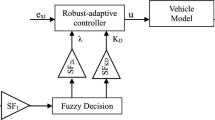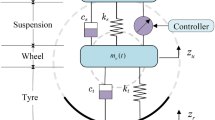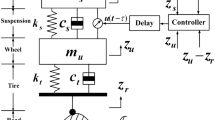Abstract
This paper proposes a new fuzzy preview control method for an electro-hydraulic suspension system to further improve the suspension performance and extend the results to practical situations that use the actual actuator in a preview suspension system. A new augmented system that includes hydraulic actuators and preview information of road disturbances is proposed and described by the T-S fuzzy system. Based on the parallel distributed compensation (PDC) and multi-objective H∞/GH2 control design scheme, the fuzzy preview controller is designed for a newly obtained model in which the closed-loop suspension system is asymptotically stable with guaranteed robust performance in the H∞ sense. The simulation results clearly validate the effectiveness of the proposed controllers in terms of its suspension performance.
Similar content being viewed by others
References
D. Hrovat, “Survey of advanced suspension developments and related optimal control applications,” Automatica, vol. 33, no. 10, pp. 1781–1817, 1997.
R. A. Williams, “Automotive active suspensions,” Proc. Inst. Mech. Eng. Part D: Journ. Automobile Eng., vol. 211, pp. 415–444, 1997.
M. Yamashita, K. Fujimori, K. Hayakawa, and H. Kimura, “Application of H ∞ control to active suspension systems,” Autometica, vol. 30, no.11, pp. 1717–1729, 1994.
W. Sun, Y. Zhao, J. Li, L. Zhang, and H. Gao, “Active suspension control with frequency band constraints and actuator input delay,” IEEE Trans. Ind. Electron., vol. 59, no. 1, pp. 530–537, 2012.
J. Cao, H. Liu, P. Li, and D. Brown, “State of the art in vehicle active suspension adaptive control systems based on intelligent methodologies,” IEEE Trans. Intell. Transp. Syst., vol. 9, no. 3, pp. 392–405, 2008.
J. Wang and D. A. Wilson, “Mixed GL 2/H 2/GH 2 control with pole placement and its application to vehicle suspension systems,” Int Journ. Contr., vol. 74, no. 13, pp. 1353–1369, 2001.
H. Gao, W. Sun, and P. Shi, “Robust sampled-data H ∞ control for vehicle active suspension systems,” IEEE Trans. Contr. Syst. Technol., vol. 18, no. 1, pp. 238–245, 2010.
H. Lim, S. H. Lee, B. R. So, and B. J. Yi, “Design of a New 6-DOF Parallel Mechanism with a Suspended Platform,” Int Journ. Contr. Autom. and Syst., vol. 13, no. 4, pp. 942–950, 2015.
H. Du and N. Zang, “H ∞ control of active vehicle suspension with actuator time delay,” Journ. Sound Vib., vol. 301, no. 1–2, pp. 236–252, 2007.
H. Chen and K. Guo, “Constrained H ∞ control of active suspensions: an LMI approach,” IEEE Trans. Contr. Syst. Technol., vol. 13, no. 3, pp. 412–421, 2005.
H. D. Choi, C. K. Ahn, M. T. Lim, and M. K. Song, “Dynamic output-feedback H ∞ control for active half-vehicle suspension systems with time-varying input delay,” Int Journ. Contr. Autom. and Syst., vol. 14, no. 1, pp. 59–68, 2016.
S. Boyd, L. E. Ghaoui, E. Feron, and V. Balakrishnan, Linear Matrix Inequalities in System and Control Theory, Philadelphia, PA, USA: SIAM, 1994.
C. Kaddissi, J. P. Kenne, and M. Saad, “Identification and real-time control of an electrohydraulic servo system based on nonlinear backstepping,” IEEE/ASME Trans. Mechatronics, vol. 12, no. 1, pp. 12–22, 2007.
A. Alleyne and J. K. Hedrick, “Nonlinear adaptive control of active suspensions,” IEEE Trans. Contr. Syst. Technol., vol. 3, no. 1, pp. 94–101, 1995.
A. Alleyne, P. D. Neuhaus, and J. K. Hedrick, “Application of nonlinear control theory to electronically controlled suspensions,” Vehicle Syst. Dyn., vol. 22, no. 5, pp. 309–320, 1993.
A. G. Thompson and B. R. Davis, “Force control in electrohydraulic active suspensions revisited,” Vehicle Syst. Dyn., vol. 35, no. 3, pp. 217–222, 2001.
P. C. Chen and A. C. Huang, “Adaptive sliding control of active suspension systems with uncertain hydraulic actuator dynamics,” Vehicle Syst. Dyn., vol. 44, no. 5, pp. 357–368, 2006.
H. Du and N. Zhang, “Fuzzy control for nonlinear uncertain electrohydraulic active suspensions with input constraint,” IEEE Trans. Fuzzy Syst., vol. 17, no. 2, pp. 343–356, 2009.
H. Du and N. Zhang, “Takagi-Sugeno fuzzy control scheme for electrohydraulic active suspensions,” Control and Cybernetics, vol. 39, no. 4, pp. 1095–1115, 2010.
H. Pan, W. Sun, X. Jing, H. Gao, and J. Yao, “Adaptive tracking control for active suspension systems with nonideal actuators,” Journal of Sound and Vibration, vol. 399, no. 7, pp. 2–20, 2017.
T. Takagi and M. Sugeno, “Fuzzy identification of systems and its application to modeling and control,” IEEE Trans. Syst., Man, Cybern., vol. 15, pp. 116–132, 1985.
G. Feng, “A survey on analysis and design of model-based fuzzy control systems,” IEEE Trans. Fuzzy. Syst., vol. 14, no. 5, pp. 676–697, 2006.
H. Karimi, B. Moshiri, and C. Lucas, “Robust fuzzy linear control of a class of stochastic nonlinear time-delay systems,” Nonlinear Dyn. Syst. Theory, vol. 4, no. 3, pp. 317–332, 2004.
S. Nguang and P. Shi, “H ∞ fuzzy output feedback control design for nonlinear systems: An LMI approach,” IEEE Trans. Fuzzy. Syst., vol. 11, no. 3, pp. 331–340, 2003.
H. Li, J. Yu, C. Hilton, and H. Liu, “Adaptive sliding-mode control for nonlinear active suspension vehicle systems using T-S fuzzy approach,” IEEE Trans. Ind. Electron., vol. 60, no. 8, pp. 3328–3338, 2013.
H. D. Choi, C. K. Ahn, P. Shi, L. Wu, and M. T. Lim, “Dynamic output-feedback dissipative control for T-S fuzzy systems with time-varying input delay and output constraints,” IEEE Trans. Fuzzy Syst., vol. 25, no. 3, pp. 511–526, 2017.
H. Du and N. Zhang, “Fuzzy control for nonlinear uncertain electrohydraulic active suspensions with input constraint,” IEEE Trans. Fuzzy Syst., vol. 17, no. 2, pp. 343–356, 2009.
H. Li, H. Liu, H. Gao, and P. Shi, “Reliable fuzzy control for active suspension systems with actuator delay and fault,” IEEE Trans. Fuzzy Syst., vol. 20, no. 2, pp. 342–357, 2012.
S. Bououden, M. Chadli, and H. R. Karimi, “A robust predictive control design for nonlinear active suspension systems,” Asian Jour. of Contr., vol. 18, no. 1, pp.122–132, 2016.
E. Bender, “Optimum linear preview control with application to vehicle suspension,” Jour. Basic Engineering, vol. 90, no. 2, pp. 213–221, 1968.
M. Tomizuka, “Optimal continuous finite preview problem,” IEEE Trans. Autom. Contr., vol.21, no. 3, pp. 362–365, 1975.
A. Hac, “Optimal linear preview control of active vehicle suspension,” Vehicle Syst. Dyn., vol. 21, no. 1, pp. 167–195, 1992.
J. Marzbanrad, G. Ahmadi, H. Zohoor, and Y. Hojjat, “Stochastic optimal preview control of a vehicle suspension,” Jour. Sound Vib., vol. 275, no. 3–5, pp. 973–990, 2004.
H. Roh and Y. Park, “Stochastic optimal preview control of an active vehicle suspension,” Jour. Sound Vib., vol. 220, no. 2, pp. 313–330, 1999.
M. Elmadany, Z. Abduljabbar, and M. Foda, “Optimal preview control of active suspensions with integral constraint,” Jour. Sound Vib., vol. 9, no. 12, pp. 1377–1400, 2003.
Z. Xie, P. Wong, X. Huang, and H. Wong, “Design of an active vehicle suspension based on an enhanced PID control with wheelbase preview and tuning using genetic algorithm,” Jour. the Chinese Society of Mechanical Engineers, vol. 33, pp. 103–112, 2012.
K. Zhou, P. P. Khargonekar, J. Stoustrup, and H. H. Niemann, “Robust performance of systems with structured uncertainties in state space,” Automatica, vol. 31, no.2, pp. 249–255, 1995.
A. Akbari, G. Koch, E. Pellegrini, and B. Lohmann, “Multi-objective preview control of active vehicle suspensions: experimental results,” Advanced Computer Contr., vol. 3, pp. 497–502, 2010.
A. Akbari and B. Lohmann, “Output feedback H ∞=GH2 preview control of active vehicle suspensions: a comparison study of LQG preview,” Vehicle Syst. Dyn., vol. 48, no. 12, pp. 1475–1494, 2010.
C. Gohrle, A. Schindler, A. Wagner, and O. Sawodny, “Design and vehicle implementation of preview active suspension controllers,” IEEE Trans. Contr. Syst. Techn., vol. 22, no. 3, pp. 1135–1142, 2014.
Y. J. Xu and F. C. Liao, “Preview control for a class of time varying discrete systems with input time-delay,” Control and Decision, vol. 28, no. 3, pp. 466–470, 2013.
I. Youn, M. A. Khan, N. Uddin, E. Youn, and M. Tomizuka, “Road disturbance estimation for the optimal preview control of an active suspension systems based on tracked vehicle model,” Intern. Journ. Automotive Techn., vol. 18, no. 2, pp. 307–316, 2017.
R. Alur, C. Belta, F. Ivancic, V. Kumar, M. Mintz, G.J. Pappas, H. Rubin, and J. Schug, “Hybrid modeling and simulation of biomolecular networks, in: Hybrid Systems: Computation and Control,” Lecture Notes in Computer Science, vol. 2034, pp. 19–32, 2001.
P. Gahinet, A. Nemirovski, A. J. Laub, and M. Chilali, LMI Control Toolbox, The Mathwork INC., 1995.
Author information
Authors and Affiliations
Corresponding author
Additional information
Recommended by Associate Editor Ho Jae Lee under the direction of Editor Euntai Kim. This work was supported by the Basic Science Research Program through the National Research Foundation of Korea (NRF) funded by the Ministry of Education (Grant No. NRF-2016R1D1A1B01016071).
Hyun Duck Choi received the B.S. and integrated M.S/Ph.D. degrees in electrical engineering from Korea University, Seoul, South Korea, in 2011 and 2017, respectively. Since 2017, he has been a Senior Research Engineer with the Hyundai Mobis. His current research interests include fuzzy systems, neural networks, robust control, finite impulse response filters, finite memory controls, nonlinear systems, and their application to vehicle suspension systems.
Chang Joo Lee received his B.S. degree in the School of Electronic Engineering from Soongsil University, Seoul, Korea in 2012. Since 2012, he has been a Ph.D. candidate in the School of Electrical Engineering, Korea University. His current research interests include fuzzy systems, neural networks, robust control, FIR filters, finite memory controls, nonlinear systems, and advanced driver assistance systems.
Myo Taeg Lim received his B.S. and M.S. degrees in Electrical Engineering from Korea University, Korea, in 1985 and 1987, respectively. He also received M.S. and Ph.D. degrees in Electrical Engineering from Rutgers University, NJ, USA, in 1990 and 1994, respectively. He was a Senior Research Engineer, Samsung Advanced Institute of Technology and an Assistant Professor in the Department of Control and Instrumentation, National Changwon University, Korea. Since 1996, he has been a Professor in the School of Electrical Engineering at Korea University. His research interests include optimal and robust control, vision based motion control, and autonomous mobile robots. He is the author or coauthor of more than 80 journal papers and two books (Optimal Control of Singularly Perturbed Linear Systems and Application: High-Accuracy Techniques, Control Engineering Series, Marcel Dekker, New York, 2001; Optimal Control: Weakly Coupled Systems and Applications, Automation and Control Engineering Series, CRC Press, New York, 2009). Dr. Lim currently serves as an Editor for International Journal of Control, Automation, and Systems. He is a Fellow of the Institute of Control, Robotics and Systems, and a member of the IEEE and Korea Institute of Electrical Engineers.
Rights and permissions
About this article
Cite this article
Choi, H.D., Lee, C.J. & Lim, M.T. Fuzzy Preview Control for Half-vehicle Electro-hydraulic Suspension System. Int. J. Control Autom. Syst. 16, 2489–2500 (2018). https://doi.org/10.1007/s12555-017-0663-4
Received:
Revised:
Accepted:
Published:
Issue Date:
DOI: https://doi.org/10.1007/s12555-017-0663-4




